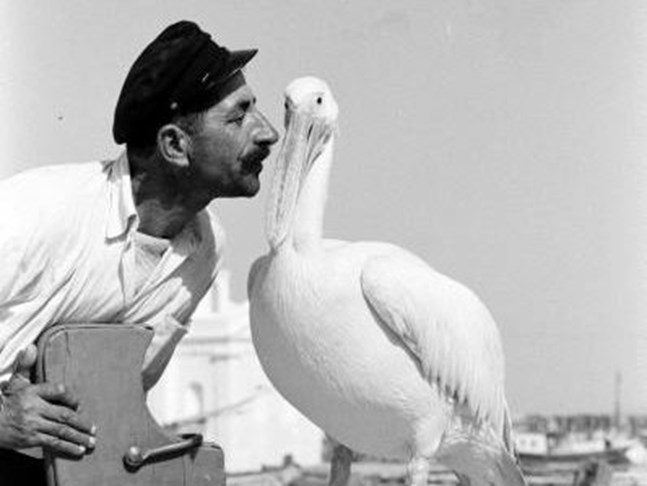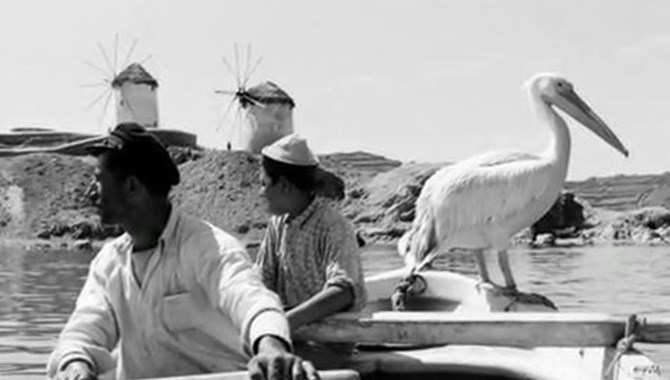
There are many stories about Petros the Pelican. Some are true, some pure fiction. But there is one thing that can be said for sure: the stubby, funny- looking bird with the impressive wing span and the long beak has been recognized as symbol of Mykonos almost as widely as its iconic windmills.
Petros the Original...
The year was 1955 or it might have been a little later, in 1958. A fisherman from Mykonos called Thodoris was out in the sea gathering his fishnets, when a large white bird fell on his boat. It was a pelican that had for some reason been separated with its flock. Astonished by the sight, since pelicans do not really frequent the Greek skies, the fisherman decided to help the poor animal and brought it back with him.
Other fishermen and islanders helped take care of the bird and bring it back to health. And the animal got so used to human presence, that never left to return to its flock. Instead, Petros, as he was called after a heroic fisherman, friend of Thodoris who had been executed by the Germans, started roaming the harbour and Chora's cobbled streets in pursue of his next meal: fishermen returning from their catch, shop owners and their customers were always eager to throw him a treat. He even had a favorite hang-out: the small chapel of Agia Moni, next to Skepathiano's fish tavern.
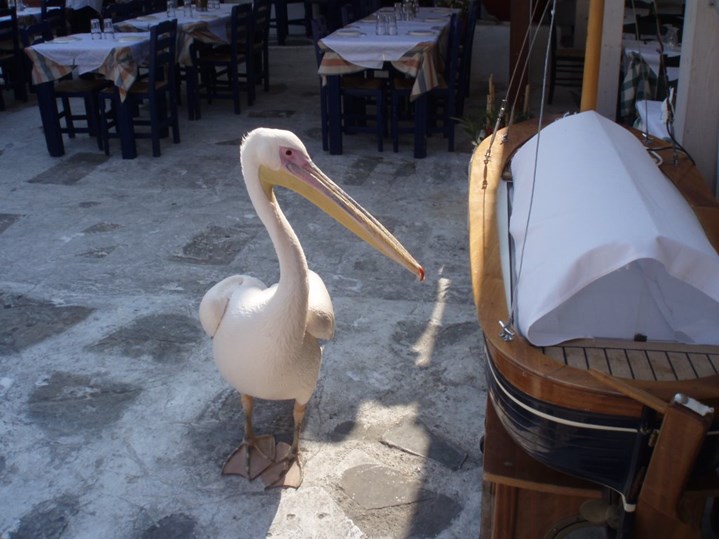
According to another version of the story, Petros was entrusted to Vassilis, an old porter who used to help unload the trade ships that docked in the port of Mykonos. Vassilis was a beloved figure of the port, famously good-hearted and really fond of animals, although he reportedly had lost one eye after a donkey kicked him when he was a little boy... Petros and Vassilis became inseparable, with the bird remaining close to the man wherever he went: on top of the sacks he carried, next to him while he was playing the traditional 'tsabouna' organ – at night, the bird slept in a little shed inside Vassilis' yard.
Petros closely followed his beloved friend even to the grave. When Vassilis passed away, Petros lost his shed and made a habit of hiding underneath vehicles to enjoy some cool shade away from the hot Mediterranean sun. One dreadful morning in 1985, a driver of such a vehicle did not see the pelican and the bird got tangled between the wheels. Mortally injured, Petros was urgently sent away to a clinic in Thessaloniki, but unfortunately it was too late... The whole island mourned his loss. The major asked for Petros to be embalmed and kept in the island's Folklor Museum, where he remains to this day.
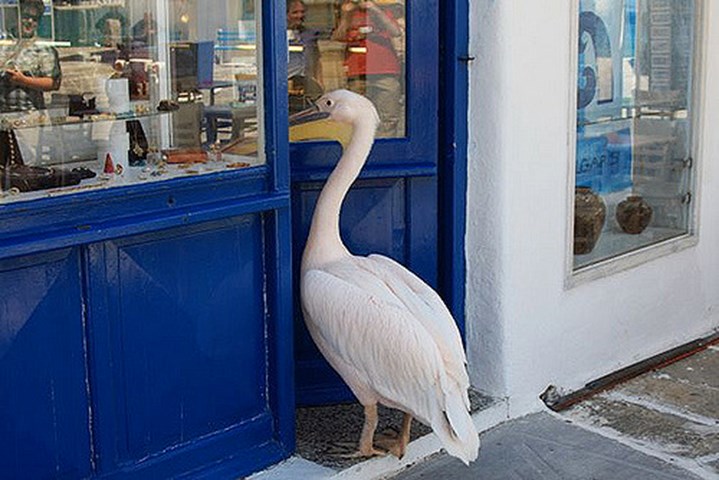
...and the Rest!
Petros is dead, long live Petros! The original bird might have had ingloriously left this world, but the pelican had already become much more than a cute bird frolicking around the island's harbour: he was the island's mascot. Mykonos could since never be without Petros and so there has been a line of successors to the original bird, together with a couple of other birds to keep him company and amuse locals and tourists.
This is another part where the story takes many turns, leaving the readers free to pick their own favourite version. In 1961, 'queen' of style and beloved fashion icon Jackie Kennedy set foot on Mykonos for the first time. One of the first island residents she met was Petros I himself and the liking each one took to the other was instant and mutual. According to some sources, the former First Lady took pity of Petros being the only pelican on the island and arranged for two more to be brought to Mykonos. Their names were Alfonso and Omega, they came from Louisiana, but they unfortunately did not live long enough to meet Petros: the long trip across the Atlantic proved too much for them and they died as soon as they reached the island... But Jackie never forgot! When she heard the devastating news that Petros had been killed, almost twenty five years later, she arranged for another pelican to be brought to the island, a female one this time: she was named Irini.
In the meantime, a rather peculiar and contradicting story seems to have taken place. Back in the time when Petros (the Original) was still alive and well, it is said that he decided to take a short trip to the neighbouring island of Tinos – the skeptics claim that he was actually... kidnapped by some residents of Tinos who grew envious of the bird's tourist attraction value! However it happened, Tineans were delighted. But the Mykoneans could not just surrender their mascot! They demanded the bird to be returned and after there were blatantly refused, they even went as far as to involve the Prefect of Cyclades as a referee! The matter was finally settled in favour of Mykonos, and Petros was safely returned.
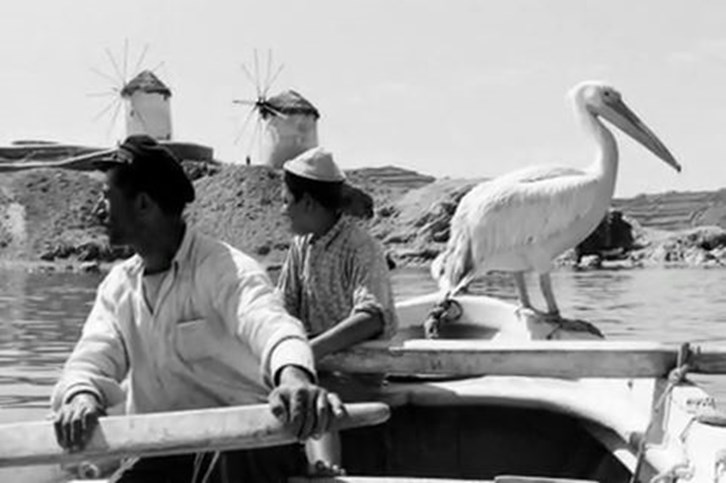
Still shocked by the sudden – even if brief – absence of Petros, the Mykoneans were desperate to find a ready substitute. Around the same time, another male pelican had been found in another neighbouring island, Andros. The Mykoneans asked to adopt him, and the people in Andros agreed. This one was named Demos, and for some time became Petros' stand-in for the island's promotion abroad: reportedly, he even went as far as the U.S. to advertise Mykonos...
The official Petros II was another male pelican sent over by the Hamburg Zoo, after Petros I flew the co-op in 1985. Ten years later, one more young male bird landed wounded on the island and remained there to keep the others company. His name was Nicholas. In 2013, Mykonos was shocked again with the news that another one of their pelicans had been run over by a car: this time it was a female bird named Georgia... Many birds seem to have come and gone, enjoying the fish, the weather and the tourists' affections. Although most of them have their own names, one is always picked to retain the title of Petros and make sure that Mykonos is never left without its mascot.
- If you happen to meet one of them, here are some handy tips:
- You may pet the pelican, but only briefly.
- You may feed them fish, but they are well mannered: they only eat out of your hand, they won't pick up anything off the ground!
- Under no circumstances should you give them alcohol! As an unfortunate incident with another pet bird in Chania (Crete) has taught us, pelicans cannot hold their liquor. It can be potentially lethal to them!








